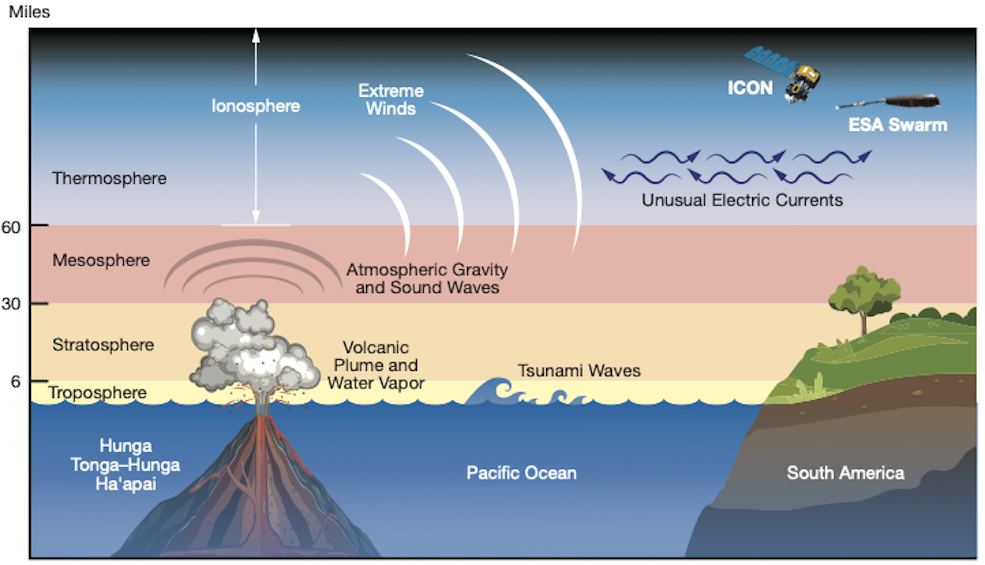The Tonga Eruption Reached Space!

Volcanic eruptions do more than send lava and clouds of noxious gas across the landscape, and trigger tsunamis and sonic booms. Sometimes they reach for space! In the case of the January 2022 underwater eruption of Tonga-Hunga Ha’apai, it sent a pressure wave through all altitudes of Earth’s atmosphere. Seismic stations and weather stations around the world (including the one on my front deck) recorded that wave as it boomeranged around the planet! And, there was another surprising result. The Tonga eruption breached Earth’s atmosphere and caused space-weather-like disruptions at the edge of space.
Understanding Space Weather
We’re all familiar with the effects of geomagnetic storms high above Earth’s surface. They are triggered by “space weather” conditions, sometimes called “space climate”. Space weather is a product of the solar wind and interactions with magnetic fields throughout the solar system. On Earth, geomagnetic storms are created by the arrival of masses of charged particles from the Sun. When those clouds of energetic particles hit our magnetic field, they disrupt electrical currents in our atmosphere. During most solar outbursts we get lovely displays of northern and southern lights. However, if the storms are strong enough, they can affect satellite communications and shut down power grids on the ground.
Atmospheric physicists spend a lot of time working with solar scientists to predict the solar outbursts that trigger space weather conditions. They also have a good handle on how geomagnetic storms affect the ionosphere. However, they’re still working on an understanding of the connection between the lower atmosphere and geomagnetic activity in near-Earth space.
Space Weather Effects from the Tonga Eruption
Given all that, imagine how surprised atmospheric scientists were when they witnessed a disturbance in the upper atmosphere that looked like space weather. It wasn’t due to a solar outburst (although the Sun was active). Instead, the disturbance was one more effect of the volcano doing what volcanoes have done for billions of years.
Here’s what happened. The Tonga eruption sent a huge plume of gases, water vapor, and dust into the sky, and created massive pressure disturbances in the atmosphere. (You can see a pretty spectacular animation of the atmospheric effect here, provided by the New York Times. ) The explosion also created huge windstorms that expanded upward toward space. NASA’s Ionospheric Connection Explorer (ICON) recorded these extreme disturbances. It was launched in 2019 to study how Earth’s weather interacts with space weather. The European Space Agency’s Swarm satellites also detected changes in ionospheric currents during the event. SWARM is part of an Earth explorer program that studies Earth’s magnetic field.
Spotting the Winds from an Eruption

In the hours after the eruption, ICON tracked the upward-traveling winds. They sped up as they moved along. By the time they reached the upper atmosphere, they clocked in at 724 km/hour (450 miles per hour). These extreme hurricane-speed winds disrupted an electric current high in the ionosphere. It’s called the equatorial electrojet. This current flows from east to west over the magnetic equator on the day side of the planet. Normally, it only gets disrupted by space weather caused by solar outbursts. But, the winds created by the force of the Tongan eruption also affected that current and caused it to actually flip its direction and flow from west to east for a time. Not only that, but the electrojet experienced a surge of power five times its normal peak.
“It’s very surprising to see the electrojet be greatly reversed by something that happened on Earth’s surface,” said Joanne Wu in a NASA press release about the event. She is a physicist at the University of California, Berkeley, and co-author of a new study of the event. “This is something we’ve only previously seen with strong geomagnetic storms.”
Learning Something New about the Ionosphere
Essentially, what scientists tracked is a disturbance similar to space weather in near-Earth space and the ionosphere. Now that they’ve seen these effects spurred by a volcanic eruption, it adds new data to their studies of space weather and its influences on our planet and our technologies.
“The volcano created one of the largest disturbances in space we’ve seen in the modern era,” said University of California Berkeley physicist Brian Harding. He is lead author on the paper outlining the effects of the eruption. “It’s allowing us to test the poorly understood connection between the lower atmosphere and space.”
For More Information
See the first schematic animation made of the atmospheric pressure wave, made a few days after the Tonga eruption.
Learn more about the ICON mission here, and the SWARM satellites here.
NASA Mission Finds Tonga Volcanic Eruption Effects Reached Space
More about space weather:
Haystack Observatory Geospace and Atmospheric Science
NASA Space Weather page
Question about Space Weather: NASA Scientists Have Answers
The post The Tonga Eruption Reached Space! appeared first on Universe Today.
Universe Today
Go to Source